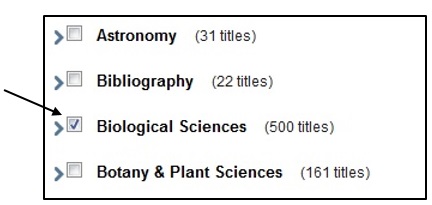
The three best databases to search for this assignment are listed below. For search tips, please see the boxes to the right.
1. Begin by typing your search term(s) in the box provided and clicking "Search."

2. After you do your search, you will see your search results, along with other search limit options on the left side of the screen. Limit your results to the last ten years by sliding the year range option on the left side to the right.

3. You may wish to narrow your results by adding further search terms to the box at the top of the limit options, or by clicking on "Advanced Search" at the top of the screen.


4. Start browsing your results for appropriate articles. Click on the titles of those that like like possibilities, and read the abstract to make sure it matches the content you want, and that it is a primary source.

5. Click "Download PDF" to read the entire article.

6. To find similar articles, first, click on the article title, then click on the tab labeled "Cited By" to see what other articles cite this article.

1. First, scroll down the screen to the section titled "Narrow by Discipline and/or Publication Title" and check the box next to "Biological Sciences."

2. Now, type your search terms into the search boxes (you can add more than two search boxes by clicking the "Add Field+" button). Next, click in the "Articles" limit below the search boxes to limit to only article content and type in your date limits in the "Date Range" boxes. Click "Search."

3. To view the article, click on the article's title in the search results. This will take you straight to the full text. Read the abstract or page through a few pages of the article using the arrow to the right of the article to make sure the content is what you need, and that it is a primary source.

4. To print or save the article, click on "View PDF." Click on "Accept JSTOR's Terms and Conditions and proceed to PDF."

*Caution- JSTOR pdf files are extremely high quality scans, which means they can take a long time to print.
1. Type your search terms into the boxes. Below the search boxes, click in the box labeled "Scholarly (Peer-Reviewed) Journals." Add your date limits to the boxes labeled "Published Date."

2. In your list of results, hover your mouse over the preview button on the right side of each item to see a preview of the abstract. To see a full abstract or more details about the articles, click on the title.

Tip: Clicking on the article's title, then looking at the list of "Subject Terms" often suggests new keywords to search.

3. If there is a full text link, click on it to view the article. Otherwise, see the tab on "finding the full text of articles" for information on how to access or request the full text of articles you are interested in.

Google Scholar searches many academic publisher and higher education websites, as well as court opinions, institutional repositories, and Google Books.
It can be a good way to find scholarly articles, in addition to the library subscription databases discussed above.
However,
You can make Google Scholar more useful to you, as a Millikin student, by turning on your "library links." This is done automatically on campus lab computers, but on your own personal laptop or home computer, here's how:
1. Click on "Settings" at the top of the page.

2. Click on "Library links" on the left side of the page.

3. Type "Millikin University" in the search box and search. Check off all the "Millikin" options presented to you. Click "Save."

4. Now, when you search, you will see Millikin options to help you obtain the full text of articles, or locate books at our library, listed to the right of results, or under the "More" option with each result.

